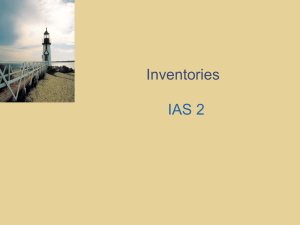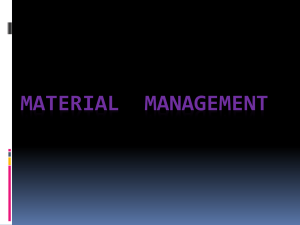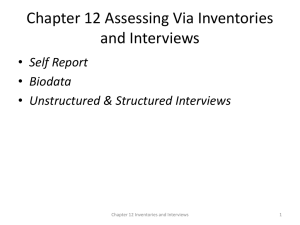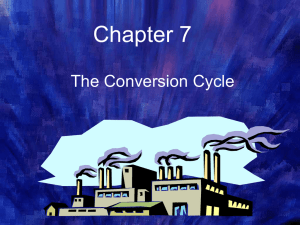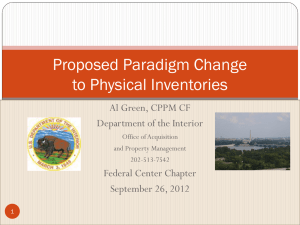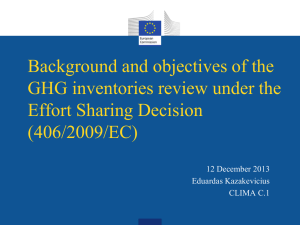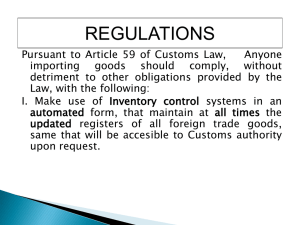IAS 2 - Inventories
advertisement
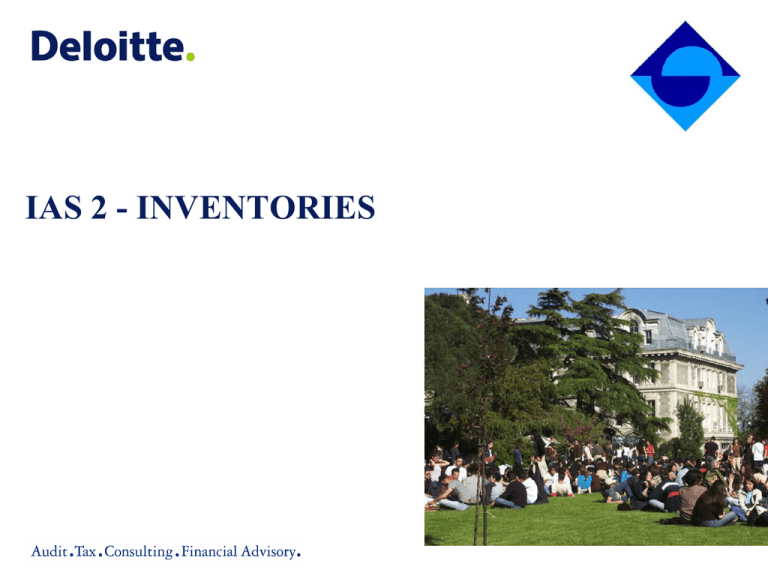
IAS 2 - INVENTORIES Objective and Scope OBJECTIVE: The objective of this Standard is to prescribe the accounting treatment for inventories. SCOPE: UMS 2 applies to all inventories, expect: a) Work in progress arising under construction contracts, including directly related service contracts (see IAS 11 Construction Contracts) b) Financial instruments (see IAS 39 Financial Instruments) c) Biological assets related to agricultural activity and agricultural produce at the point of harvest (see IAS 41 Agriculture) 2 Definitions Inventories a) Held for sale in the ordinary course of business; b) In the process of production for such sale; c) In the form of materials or supplies to be consumed in the production process or in the rendering of services. 3 Definitions Net Realizable Value / Fair Value • Net Realizable Value: is the estimated selling price in the ordinary course of business less the estimated cost of completion and the estimated costs necessary to make the sale. • Fair Value: is the amount for which an asset could be exchanged, or a liability settled, between knowledgeable, willing parties in an arm’s length transaction. 4 Cost and Valuation • Inventories shall be measured at the lower of cost and net realisable value • The cost of inventories shall comprise all costs of purchase, cost of conversion and other costs incurred in bringing the inventories to their present location and condition. 5 Cost of Purchase Cost of Purchase The cost of purchase of inventories comprise the purchase price, import duties and other taxes, transport, handling and other costs directly attributable to the acquisition of finished goods, materials and services. Trade discounts, rebates and other similar items are deducted in determining the cost of purchase. 6 Costs of Conversion The costs of conversion of inventories include costs directly related to the units of production, such as direct labour. They also include a systematic allocation of fixed and variable production averheads that are incurred in converting materials into finished goods. The allocation of fixed production overheads to the costs of conversion is based on the normal capacity of the production facilities. The amount of fixed overhead allocated to each unit of production is not increased as a consequence of low production or idle plant. 7 Costs items excluded from cost of inventories a) Abnormal amounts of wasted materials, labor or other production costs b) Storage costs, unless those costs are necessary in the production process before a further production stage c) Administrative overheads d) Selling costs 8 IAS 2 Revised Differences: • IAS 2 does not permit exchange differences arising directly on the recent acquisition of inventories invoiced in a foreign currency to be included in the costs of purchase of inventories. • Paragraph 18 was inserted to clarify that when inventories are purchased with deferred settlement terms, the difference between the purchase price for normal credit terms and the amount paid is recognized as interest expense over the period of financing. • The Standard does not permit the use of the last-in, first-out (LIFO) formula to measure the cost of inventories. 9 Cost Formulas • Goods or services produced and segregated for specific projects shall be assigned by using specific identification of their individual costs • The First-in, First out (FIFO) • Weighted average cost formula • An entity shall use the same cost formula for all inventories having a similar nature and use to the entity. For inventories with a different nature or use, different cost formulas may be justified. 10 Net Realisable Value Estimated Selling Price Discounts Estimated cost of completion Selling Costs X (X) (X) (X) --X Net Realisable Value 11 Provision for inventory impairment • The cost of inventories may not be recoverable if those inventories are damaged, if they have become wholly or partially obsolete, or if their selling prices have declined. The cost of inventories may also not be recoverable if the estimated costs of completion or the estimated costs to be incurred to make the sale have increased. The practice of writing inventories down below cost to net realisable value is consistent with the view that assets should not be carried in excess of amounts expected to be realized from their sale or use. • Materials and other supplies held for use in the production of inventories are not written down below cost if the finished products in which they will be incorporated are expected to be sold at or above cost. 12 Disclosure • • • • • • • • The accounting policies adopted in measuring inventories, including the cost of formula used, The total carrying amount of inventories and the carrying amount in classifications appropriate to the entity, the carrying amount of inventories carried at fair value less costs to sell, the amount of inventories recognized as an expense during the period, the amount of any write-down of inventories recognized as an expense in the period, the amount of any reversal of any write-down that is recognized as a reduction, in the amount of inventories recognized as expense, the circumstances or events that led to the reversal of a write-down of inventories, the carrying amount of inventories pledged as security for liabilities. 13 Recognition as an Expense • • • When inventories are sold, the carrying amount of those inventories shall be recognized as an expense in the period in which the related revenue is recognized. The amount of any write-down of inventories to net realisable value and all losses of inventories shall be recognized as an expense in the period the writedown or loss. The amount of any reversal of any write-down of inventories, arising from an increase in net realisable value, shall be recognized as a reduction in the amount of inventories recognized as an expense in the period in which the reversal occurs. 14 15
